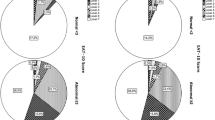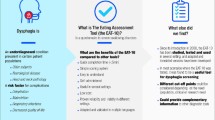Abstract
Self-perception of disease is increasingly recognized as a determinant of health. The Eating Assessment Tool-10 (EAT-10) is a functional health status questionnaire that measures the symptomatic severity of dysphagia from the patient’s perspective. The objective of this work was to identify factors (demographics, clinical variables, swallowing physiology, health-related quality of life) associated with longitudinal change in EAT-10 scores in outpatients with oropharyngeal dysphagia at a multi-disciplinary, tertiary care clinic. All patients with swallowing concerns that were included in the UW Madison Voice and Swallowing Outcomes database from 12/2012 to 04/2015 were invited to complete EAT-10 and a general health-related quality of life survey (SF-12v2) at their initial evaluation and six months later. Forty-two patients were included in analysis (n = 42). Weaning from a gastrostomy tube was significantly associated with EAT-10 improvement. Approximately 70% of the sample had mild dysphagia, and floor effects were observed for all EAT-10 items in this sample subset. Mean SF-12v2 Physical Component Summary score was substantially lower than that of the general population. Significant, weak–moderate correlations were found between EAT-10 and SF-12v2 scores for all comparisons except for Physical Health Composite at six months (rs = = 0.24 to − 0.43). Weaning from a feeding tube appears to meaningfully improve self-perceived symptoms of dysphagia. Given the floor effects observed, validity of EAT-10 for patients with mild dysphagia should be examined. Future research should address contributors to self-perceived symptom change across the range of dysphagia severity.


Similar content being viewed by others
References
Ekberg O, Hamdy S, Woisard V, et al. Social and psychological burden of dysphagia: its impact on diagnosis and treatment. Dysphagia. 2002;17:139–46. https://doi.org/10.1007/s00455-001-0113-5.
Tibbling L, Gustafsson B. Dysphagia and its consequences in the elderly. Dysphagia. 1991;6:200–2. https://doi.org/10.1007/BF02493526.
Miller N, Noble E, Jones D, Burn D. Hard to swallow: dysphagia in Parkinson’s disease. Age Ageing. 2006;35:614–8. https://doi.org/10.1093/ageing/afl105.
Steele CM, Greenwood C, Ens I, et al. Mealtime difficulties in a home for the aged: not just dysphagia. Dysphagia. 1997;12:43–51. https://doi.org/10.1007/PL00009517.
Nozaki S, Saito T, Matsumura T, et al. Relationship between weight loss and dysphagia in patients with Parkinson’s disease. Rinshō Shinkeigaku. 1999;39:1010–4.
Beal AC. The Patient-Centered Outcomes Research Institute (PCORI) National Priorities for Research and Initial Research Agenda. JAMA. 2012;307:1583. https://doi.org/10.1001/jama.2012.500.
Robbins J, Langmore S, Hind JA, Erlichman M. Dysphagia research in the 21st century and beyond: proceedings from Dysphagia Experts Meeting, August 21, 2001. J Rehabil Res Dev. 2002;39:543–8.
Petrie K, Jago LA, Devcich DA. The role of illness perceptions in patients with medical conditions. Curr Opin Psychiatry. 2007;20:163–7. https://doi.org/10.1097/YCO.0b013e328014a871.
Frostholm L, Oernboel E, Christensen KS, et al. Do illness perceptions predict health outcomes in primary care patients? A 2-year follow-up study. J Psychosom Res. 2007;62:129–38. https://doi.org/10.1016/j.jpsychores.2006.09.003.
Foster NE, Bishop A, Thomas E, et al. Illness perceptions of low back pain patients in primary care: what are they, do they change and are they associated with outcome? Pain. 2008;136:177–87. https://doi.org/10.1016/j.pain.2007.12.007.
Robinson JH, Callister LC, Berry JA, Dearing KA. Patient-centered care and adherence: definitions and applications to improve outcomes. J Am Acad Nurse Pract. 2008;20:600–7. https://doi.org/10.1111/j.1745-7599.2008.00360.x.
Belafsky PC, Mouadeb DA, Rees CJ, et al. Validity and reliability of the eating assessment tool (EAT-10). Ann Otol Rhinol Laryngol. 2008;117:919–24. https://doi.org/10.1177/000348940811701210.
Rofes L, Arreola V, Mukherjee R, Clavé P. Sensitivity and specificity of the Eating Assessment Tool and the Volume-Viscosity Swallow Test for clinical evaluation of oropharyngeal dysphagia. Neurogastroenterol Motil. 2014. https://doi.org/10.1111/nmo.12382.
Cheney DM, Tausif Siddiqui M, Litts JK, et al. The ability of the 10-item eating assessment tool (EAT-10) to predict aspiration risk in persons with dysphagia. Ann Otol Rhinol Laryngol. 2015;124:351–4. https://doi.org/10.1177/0003489414558107.
Wakabayashi H, Matsushima M. Dysphagia assessed by the 10-item eating assessment tool is associated with nutritional status and activities of daily living in elderly individuals requiring long-term care. J Nutr Heal Aging. 2016;20:22–7. https://doi.org/10.1007/s12603-016-0671-8.
Plowman EK, Tabor LC, Robison R, et al. Discriminant ability of the Eating Assessment Tool-10 to detect aspiration in individuals with amyotrophic lateral sclerosis. Neurogastroenterol Motil. 2016;28:85–90. https://doi.org/10.1111/nmo.12700.
E M, R C, G M, et al. Prevalence of dysphagia in the older using “Eating Assessment Tool-10”. Eur J Hosp Pharm Sci Pract. 2012;19:205–6. https://doi.org/10.1136/ejhpharm-2012-000074.316.
Speyer R, Kertscher B, Cordier R. Functional health status in oropharyngeal dysphagia. J Gastroenterol Hepatol Res. 2014;3:1043–8. https://doi.org/10.6051/j.issn.2224-3992.2014.03.408-9.
Rofes L, Arreola V, López I, et al. Effect of surface sensory and motor electrical stimulation on chronic poststroke oropharyngeal dysfunction. Neurogastroenterol Motil. 2013. https://doi.org/10.1111/nmo.12211.
Wallace KL, Middleton S, Cook IJ. Development and validation of a self-report symptom inventory to assess the severity of oral-pharyngeal dysphagia. Gastroenterology. 2000;118:678–87. https://doi.org/10.1016/S0016-5085(00)70137-5.
Skeppholm M, Ingebro C, Engström T, Olerud C. The dysphagia short questionnaire: an instrument for evaluation of dysphagia: a validation study with 12 months’ follow-up after anterior cervical spine surgery. Spine. 2012;37:996–1002. https://doi.org/10.1097/BRS.0b013e31823a7a5b.
Speyer R, Cordier R, Kertscher B, Heijnen BJ. Psychometric properties of questionnaires on functional health status in oropharyngeal dysphagia: a systematic literature review. Biomed Res Int. 2014;2014:1–11.
Ware JJ, Kosinski MM, Keller SSD. A 12-Item Short-Form Health Survey: construction of scales and preliminary tests of reliability and validity. Med Care. 1996;34:220–33. https://doi.org/10.2307/3766749.
Ware JE, Kosinski M, Keller SD. How to score the SF-12 physical and mental health summary scales. 2nd ed. Boston: The Health Institute, New England Medical Center; 1998.
Gandek B, Ware JE, Aaronson NK, et al. Cross-validation of item selection and scoring for the SF-12 Health Survey in nine countries: results from the IQOLA Project. J Clin Epidemiol. 1998;51:1171–8. https://doi.org/10.1016/S0895-4356(98)00109-7.
Luo X, Lynn George M, Kakouras I, et al. Reliability, validity, and responsiveness of the Short Form 12-Item Survey (SF-12) in patients with back pain. Spine. 2003;28:1739–45. https://doi.org/10.1097/01.BRS.0000083169.58671.96.
Resnick B, Nahm ES. Reliability and validity testing of the revised 12-item Short-Form Health Survey in older adults. J Nurs Meas. 2001;9:151–61.
Schindler A, Mozzanica F, Monzani A, et al. Reliability and validity of the Italian eating assessment tool. Ann Otol Rhinol Laryngol. 2013;122:717–24.
Quan H, Sundararajan V, Halfon P, et al. Coding algorithms for defining comorbidities in ICD-9-CM and ICD-10 administrative data. Med Care. 2005;43:1130–9.
Weinman J, Petrie KJ. Illness perceptions: a new paradigm for psychossomatics? J Psychosom Res. 1997;42:113–6. https://doi.org/10.1016/S0022-3999(96)00294-2.
Kumar S, Langmore S, Goddeau RP, et al. Predictors of percutaneous endoscopic gastrostomy tube placement in patients with severe dysphagia from an acute-subacute hemispheric infarction. J Stroke Cerebrovasc Dis. 2012;21:114–20. https://doi.org/10.1016/j.jstrokecerebrovasdis.2010.05.010.
Giraldo-Cadavid LF, Gutierrez-Achury AM, Ruales-Suarez K, et al. Validation of the Spanish Version of the Eating Assessment Tool-10 (EAT-10spa) in Colombia. A Blinded Prospective Cohort Study. Dysphagia. 2016;31:398–406. https://doi.org/10.1007/s00455-016-9690-1.
Cordier R, Joosten A, Clave P, et al. Evaluating the Psychometric Properties of the Eating Assessment Tool (EAT-10) using rasch analysis. Dysphagia. 2017;32:250–60. https://doi.org/10.1007/s00455-016-9754-2.
McHorney CA, Tarlov AR. Individual-patient monitoring in clinical practice: are available health status surveys adequate? Qual Life Res. 1995;4:293–307. https://doi.org/10.1007/BF01593882.
Terwee CB, Bot SDM, de Boer MR, et al. Quality criteria were proposed for measurement properties of health status questionnaires. J Clin Epidemiol. 2007;60:34–42. https://doi.org/10.1016/j.jclinepi.2006.03.012.
Hyland ME. A brief guide to the selection of quality of life instrument. Health Qual Life Outcomes. 2003;1:24. https://doi.org/10.1186/1477-7525-1-24.
Patel DA, Sharda R, Hovis KL, et al. Patient-reported outcome measures in dysphagia: a systematic review of instrument development and validation. Dis Esophagus. 2017;30:1–23. https://doi.org/10.1093/dote/dow028.
Terrell JE, Ronis DL, Fowler KE, et al. Clinical predictors of quality of life in patients with head and neck cancer. Arch Otolaryngol Neck Surg. 2004;130:401. https://doi.org/10.1001/archotol.130.4.401.
Rogers SN, Thomson R, O’Toole P, Lowe D. Patients experience with long-term percutaneous endoscopic gastrostomy feeding following primary surgery for oral and oropharyngeal cancer. Oral Oncol. 2007;43:499–507. https://doi.org/10.1016/j.oraloncology.2006.05.002.
Bannerman E, Pendlebury J, Phillips F, Ghosh S. A cross-sectional and longitudinal study of health-related quality of life after percutaneous gastrostomy. Eur J Gastroenterol Hepatol. 2000;12:1101–9.
Senft M, Fietkau R, Iro H. The influence of supportive nutritional therapy via percutaneous endoscopically guided gastrostomy on the quality of life of cancer patients. Support Care Cancer. 1993;180:272–5.
Mahant S, Friedman JN, Connolly B, et al. Tube feeding and quality of life in children with severe neurological impairment. Arch Dis Child. 2009;94:668–73. https://doi.org/10.1136/adc.2008.149542.
Sneeuw KC, Aaronson NK, Sprangers MA, et al. Comparison of patient and proxy EORTC QLQ-C30 ratings in assessing the quality of life of cancer patients. J Clin Epidemiol. 1998;51:617–31.
Wilson IB. Linking clinical variables with health-related quality of life. A conceptual model of patient outcomes. JAMA, J Am Med Assoc. 1995;273:59–65. https://doi.org/10.1001/jama.273.1.59.
Guyatt GH. Measurement of health-related quality of life in heart failure. J Am Coll Cardiol. 1993;22:A185–91. https://doi.org/10.1016/0735-1097(93)90488-M.
Chen A, Frankowski R, Bishop-Leone J, et al. The Development and validation of a dysphagia-specific Quality-of-life questionnaire for patients with head and neck cancer. Head Neck. 2005;127:870–6.
Chen AY, Frankowski R, Bishop-Leone J, et al. The development and validation of a dysphagia-specific quality-of-life questionnaire for patients with head and neck cancer: the M. D. Anderson dysphagia inventory. Arch Otolaryngol Head Neck Surg. 2001;127:870–6.
McHorney CA, Robbins JA, Lomax K, et al. The SWAL-QOL and SWAL-CARE outcomes tool for oropharyngeal dysphagia in adults: III. Documentation of reliability and validity. Dysphagia. 2002;17:97–114. https://doi.org/10.1007/s00455-001-0109-1.
Motheral B, Brooks J, Clark MA, et al. A checklist for retrospective database studies—Report of the ISPOR task force on retrospective databases. Value Heal. 2003;6:90–7. https://doi.org/10.1046/j.1524-4733.2003.00242.x.
Arthur A. Stone, Christine A. Bachrach, Jared B. Jobe, Howard S. Kurtzman, Virginia S. Cain. The science of self-report: implications for research and practice. Psychology Press: Hove: 1999.
Krieger N, Waterman P, Chen JT, et al. Zip code caveat: bias due to spatiotemporal mismatches between zip codes and US census-defined geographic areas—The public health disparities geocoding project. Am J Public Health. 2002;92:1100–2. https://doi.org/10.2105/AJPH.92.7.1100.
Grubesic TH, Matisziw TC. On the use of ZIP codes and ZIP code tabulation areas (ZCTAs) for the spatial analysis of epidemiological data. Int J Health Geogr. 2006;5:58. https://doi.org/10.1186/1476-072X-5-58.
Acknowledgements
The authors thank Glen Leverson, PhD for statistical assistance, Elisa R. Derickson for database support, and Beth Harper for guidance with American Community Survey data.
Funding
This study was funded by National Institutes of Health NIDCD (R01 4336).
Author information
Authors and Affiliations
Corresponding author
Ethics declarations
Conflict of interest
No conflicts of interest exist.
Ethical Approval
All procedures performed in studies involving human participants were in accordance with the ethical standards of the institutional and/or national research committee and with the 1964 Helsinki Declaration and its later amendments or comparable ethical standards.
Informed Consent
Informed consent was obtained from all individual participants included in the study.
Additional information
All work was performed at University of Wisconsin-Madison in Madison, Wisconsin.
Rights and permissions
About this article
Cite this article
Bartlett, R.S., Moore, J.E. & Thibeault, S.L. Temporal Analysis of Factors Associated with EAT-10 in Outpatients with Oropharyngeal Dysphagia from a Tertiary Care Clinic. Dysphagia 33, 457–467 (2018). https://doi.org/10.1007/s00455-018-9874-y
Received:
Accepted:
Published:
Issue Date:
DOI: https://doi.org/10.1007/s00455-018-9874-y




